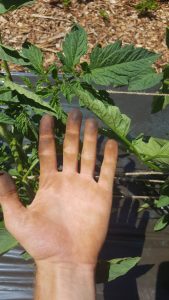Can you smell that? That is the hand of a tomato pruner hard at work, pruning the indeterminate varieties of the trial: JTO 1007, JTO 1021, PILU KS, Frederick, and Damsel. The difference between and indeterminate and determinate tomato variety is found in their growth habit; indeterminate varieties have vine like growth and will produce fruit in multiple successions in a growing season, where determinate varieties grow more bushy and set all of their fruit at once. The indeterminate varieties are pruned to promote the vertical and vine-like growth, as well as promoting a healthier setting of fruit. The theory behind this is that when less photosynthetic energy is being spent to grow many lateral branches, the plant can reinvest that energy into 2-3 leaders (branches with apical dominance) that will be producing the majority of the fruit.
While I was pruning the plants, that have now grown to reach the second line of trellising, I was able to be up close and personal with all of them, keeping my eyes open for insects and insect damage. The flea beetles and flea beetle damage that I had observed on a majority of the plants last week remains isolated to the older leaves, and while I still saw flea beetles on some of the plants (far fewer than last week) the extent of the damage is of little concern to the overall health of the plant, in my opinion. Also seen today were two small populations of aphids (≈10 aphids) on two different plants, one population on a PILU KS plant in plot 2 and the other on a Crimson Sprinter plant also in plot 2. I will keep my eye on these.
—-
I want to encourage you to visit the NOVIC website and read about their mission and about some of the exciting projects that they are a part of, there is a link to their website in the Who We Are menu.
NOVIC collaborates with The Organic Seed Alliance who was just highlighted in a piece by The New York Times about the importance of healthy and Organic seed. You should read the piece here.
An important part of the NOVIC goal is the merging of the culinary arts with the plant breeders and farmers that are producing the food that we all love to eat. You can learn more about this at The Culinary Breeding Network. Here is a link to their upcoming events.


Leave a Reply